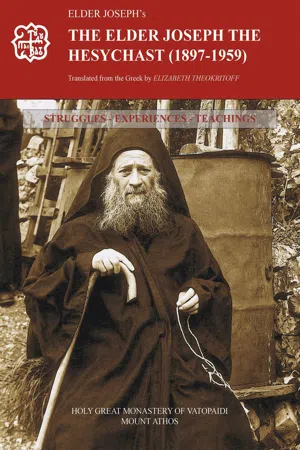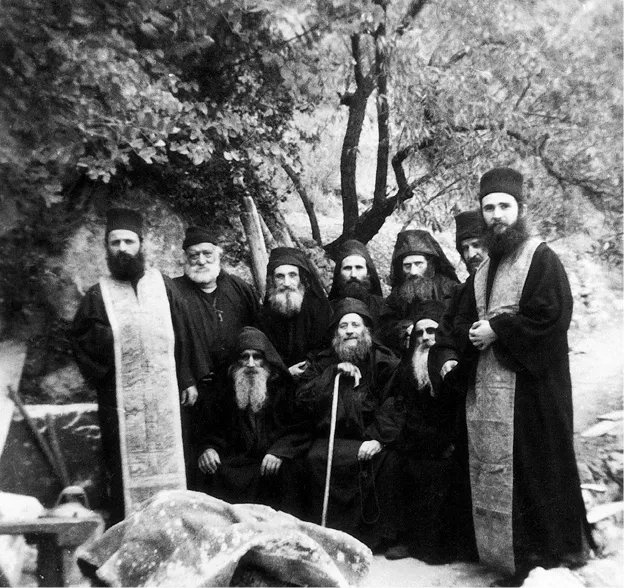![]()
INTRODUCTION
It is only natural for noble memories to be recorded, so that they remain forever as glowing landmarks in spiritual history. This is all the more necessary these days, when life is in such a state of flux and rapid evolution that the traditional foundations are being almost completely altered. Anyone of an advanced age will have something to say from his experience of the past, as a witness to events and a source of reliable information. But this is also an obligation which creates history. This is how knowledge about the lives of former generations is handed down to us – of how they lived, how and what they thought and what their social and spiritual life was like.
It is on these grounds that we write these lines, because we wanted to leave a living memory of some aspects of monastic life – something that anyway corresponds to my own bent, since I became a monk at an early age. My impressions –which without doubt are those of a monk– revolve mainly around the life and words of devout and virtuous monks and elders whom I have met or heard about from reliable sources. From my youth I was thrilled by the Lives of the Saints, and I always cherished the hope that one day I might meet people like that, true workers of virtue, heroes in the practice of arduous ascetic labours and genuine friends of God, filled with divine love towards God and their neighbour.
Nearly two millennia have passed in the history of our Church, during which the bitter struggle of good and evil has gone stubbornly on and their respective supporters have constantly clashed. However much the workers of virtue diminish in number –the ‘little flock’, in the words of Our Lord – they have not ceased to be a presence in every age, even under harsh conditions. And this is because we are simply seeing the fulfilment of the Lord’s prophecy that ‘the gates of Hell shall not prevail against the Church and the flock of Christ’ (Mt. 16:18), and because indeed ‘He who is in you is greater than he who is in the world’
Monasticism goes back almost to the days of the holy Apostles, and started to be organised after the third century in Egypt and Palestine. The initial solitary way of life was followed by a communal life, first in lavras that were semi-coenobitic and later with a purely coenobitic rule. According to sacred tradition, the monks under Pachomius the Great at Tabennisi, by the mouth of the Nile, received the rule and foundation for their communal life in a revelation from an angel of God. The basic characteristic of this rule which was given them was a slight variation from coenobitic life in a strict sense to accommodate the desire and godly fervour of the spiritual warriors of the time – a degree of independence as to the intensity of their spiritual struggle. Each was allowed to make his own choices as to diet, form of struggle, ascetic labour, vigil, prayer and whatever else.
In a relatively short time this tradition spread to Palestine, where Theodosius the Great instituted the purely coenobitic life, for which he is called the Coenobiarch. During this period, monasticism spread to almost every part of the world where the Church was to be found. Monasteries, sketes and hermitages were built, where zealous Christians would resort to putting the commandments of the Gospel into practice according to their desire and their fervour, devoting themselves solely to the things of God. In the East the monks were not left in peace for long, especially after the spread of Islam, which was undoubtedly a sore trial for Christendom.
Thus began the gradual movement towards the area around Byzantium, and Olympus in Bithynia (Asia Minor) became a thriving centre. In Constantinople as well the Studites flourished, renowned for their zeal for the patristic tradition and architects of our hymnology in its detailed form, building on a tradition received from the famous Lavra of St Sava in Palestine. But here, too, the iconoclast heresy did not allow them to dedicate themselves in peace to their monastic labours, and the search began for a new place to continue this sacred tradition.
So begins the history of Holy Athos, which from that time has remained down the years an unshakeable bastion of true piety and virtue, the spiritual and fragrant paradise of the Most Blessed Mother of God, whose special love and care for it continues to be made manifest in practical ways.
As it is not our intention to write a general history of monasticism, we will not be going into details in our brief account. We have given this summary sketch only because we shall refer later to the spiritual warriors of Mount Athos, the legitimate continuators of our patristic tradition.
It is sad indeed that despite the rich spiritual contribution of Athonite monasticism which has survived and thrived uninterrupted for more than a thousand years, nothing has been written that is worthy of its splendour. Even the names of those who passed through and handed on this rich heritage have not been written down. We are unequal to this task and also untimely born, having missed almost all the vast wealth of this spiritual heaven. Indeed, Athos has stood permanently between earth and heaven, to reconcile the human race with God and, often, to stand in the way of the divine justice which human treachery has provoked.
When we first started out in our own homeland, the first thing we learned about monastic life was the Holy Mountain. This was because it happened that both our Abbot Barnabas and the spiritual father of our monastery, Priest-monk Kyprianos, had previously been Athonites. They were always telling us about living images and examples of holy monks from Athos whom they themselves had seen and heard. They told us about the Elder Kallinikos the Hesychast, the Elder Gerasimos of Chios, Father Gregorios, Father Cosmas, Father Savvas, Hilarion and many others. All these were people full of godly zeal, real ascetics, true spiritual warriors, men of inwardness and watchfulness, sober, filled with divine grace and the spirit of prescience.
These vivid tales, combined with our youthful fervour at that time, were so uplifting that they kindled in us the desire to visit this holy place for ourselves. And if God did not grant us the blessing of meeting such fathers, we could at least venerate their holy relics and see at first hand the holy places where they lived and strove, and learn from their successors as much as we could about their marvellous and supranatural lives. Such were the motives that led us to set out, and so by the grace of God we found ourselves on holy Athos, where we encountered far more than we had expected or dreamed.
There is nothing strange or uncommon in recounting the lives of remarkable men and something of their feats and struggles. If only this were always done: it would offer some hope for restoring stability to a corrupted society which, alas, is inundated with contradictions. A form of impassioned love possesses people’s hearts. To a greater or lesser extent, everyone loves something, is interested in something – something occupies their minds. In their struggle to organize whatever it is they are interested in, they may be satisfied or frustrated. But taking their life as a whole, they are not satisfied, because most of their time and energy has been wasted on pitiful vanities and in the service of pointless ends. Many philosophies amd theories have been articulated and written down since the dawn of history, but there has been no improvement in this harsh reality.
Elder Joseph with his community and other fathers from Mount Athos at the New Skete
(Photograph from monk Gabriel’s album from Philotheou
“ATHOS HEAVEN AND EARTH”)
The meaning of truth is not easy for people to grasp in the place of exile and condemnation in which they find themselves. The ancient commandment of the Creator following the sin of disobedience remains inexorable: ‘and at the east of the garden of Eden God placed the cherubim, and a flaming sword which turned every way, to guard the way to the tree of life’. Entry to Eden, to joy and happiness and peace, has been forbidden for ever! In its place, the earth keeps bringing forth thorns and thistles and ‘in the sweat of your face shall you eat bread all the days of your life’.
So the fullness of time had to come for this new Gospel to overturn the ancient condemnation and grant human beings the blessing, to grant them true happiness and joy. ‘Peace I leave with you; my peace I give to you; not as the world gives do I give unto you’. Since the moment when the new Gospel gave the good news to men and revealed the true meaning of life –real peace and joy– many centuries have passed up to this day, and the course of mankind continues unimpeded towards its realisation. Indeed, ‘to all who received Him, He gave power to become children of God’.
Out of the countless heroes who continue this course we shall speak of one, whom God in His love for mankind granted us to live close to for a considerable time. ‘We have seen and heard and touched’ personally the actual life of this man, and also his thoughts, as far, of course, as it was possible for us.
The basic characteristics of this blessed Elder were the comprehensive commandments: on the one hand love for God with all his heart and soul, and for his neighbour as himself, and on the other the unrelenting, lifelong struggle with various trials in order to put this commandment into practice. It is impossible not to meet with difficulties if one...

